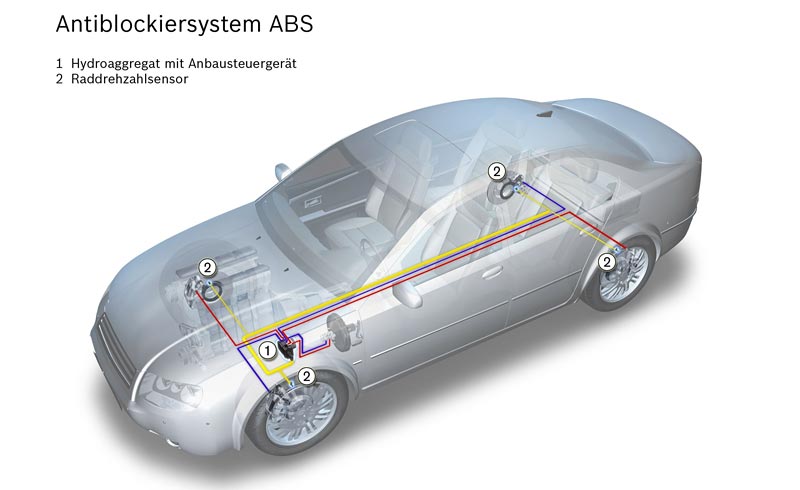Anti-lock brake system (ABS)
If the wheels lock when the brakes are fully applied, the ability to steer is lost and the vehicle can become uncontrollable. The task of the anti-lock brake system (ABS) is to permanently and effectively...
Function
 If the wheels lock when the brakes are fully applied, the ability to steer is lost and the vehicle can become uncontrollable. The task of the anti-lock brake system (ABS) is to permanently and effectively stop the wheels from locking, thereby stabilising braking. This is achieved by repeatedly and intelligently reducing and increasing the brake pressure, a procedure known as pressure modulation.
If the wheels lock when the brakes are fully applied, the ability to steer is lost and the vehicle can become uncontrollable. The task of the anti-lock brake system (ABS) is to permanently and effectively stop the wheels from locking, thereby stabilising braking. This is achieved by repeatedly and intelligently reducing and increasing the brake pressure, a procedure known as pressure modulation.
The German road traffic registration ordinance (StVZO) also uses the abbreviation ABV, which stands for anti-lock braking system.
Anti-slip control
When the driver presses hard on the brake pedal, the tyres initially switch from their normal rolling motion to what is known as the brake slip range. The rolling circumference of the tyre is less than the distance the vehicle is covering. If the driver presses the brake pedal even harder, the wheel will lock. This is referred to as 100% brake slip.
With modern tyres and "standard road surfaces", optimum braking deceleration is reached at a brake slip of between approximately 8 and 25%. Even experienced drivers will find it difficult to reach this narrow, optimum range; they will not be able to reach it at all in extreme circumstances. The intelligent ABS system regulates the brake force so that the slip at each wheel remains within the optimum range and individual wheels do not lock at the same time.
Different systems
In the past, three-channel anti-lock systems were the most popular. Systems of this type control the front wheels separately and the rear wheels are jointly. Most of today's vehicles feature four-channel ABS systems, which enable the brake pressure to be controlled separately at each wheel. On vehicles with anti-lock systems, each wheel has a wheel speed sensor.
The sensor tells the electronic control unit the current speed of all wheels at any given time. If an individual wheel is decelerated more sharply during braking, exceeding the target slip range, the brake pressure of this wheel is maintained or reduced. This rule applies above a minimum velocity of 6 km/h. As long as the driver continues to press the brake pedal, the velocity of the vehicle will be permanently matched to the velocity at which the individual wheels are travelling. As a result, the break pressure is continuously modulated.
The anti-lock system comprises the following components:
- Wheel speed sensors. Wheel speed sensors must capture the current wheel speed and report it to the electronic control unit in the form of an electrical signal.
- "HECU" control unit. The HECU control unit must evaluate the signals. It comprises the hydraulic unit (hydraulic block with valves, integrated pump with electric motor and low pressure accumulator) and the electronics unit (coil carrier with electronic control unit).
- Wheel brake. The wheel brake converts the braking effect at the wheels, each of which is controlled separately.
Anti-slip control
When the driver presses hard on the brake pedal, the tyres initially switch from their normal rolling motion to what is known as the brake slip range. The rolling circumference of the tyre is less than the distance the vehicle is covering. If the driver presses the brake pedal even harder, the wheel will lock. This is referred to as 100% brake slip. With modern tyres and "standard road surfaces", optimum braking deceleration is reached at a brake slip of between approximately 8 and 25%. Even experienced drivers will find it difficult to reach this narrow, optimum range; they will not be able to reach it at all in extreme circumstances. The intelligent ABS system regulates the brake force so that the slip at each wheel remains within the optimum range and individual wheels do not lock at the same time.
Different systems
Three-channel anti-lock system
In the past, three-channel anti-lock systems were the most popular. Systems of this type control the front wheels separately and the rear wheels are jointly.
Four-channel anti-lock system
Most of today's vehicles feature four-channel ABS systems, which enable the brake pressure to be controlled separately at each wheel. On vehicles with anti-lock systems, each wheel has a wheel speed sensor.
The sensor tells the electronic control unit the current speed of all wheels at any given time. If an individual wheel is decelerated more sharply during braking, exceeding the target slip range, the brake pressure of this wheel is maintained or reduced. This rule applies above a minimum velocity of 6 km/h. As long as the driver continues to press the brake pedal, the velocity of the vehicle will be permanently matched to the velocity at which the individual wheels are travelling. As a result, the break pressure is continuously modulated.
Components of the anti-lock system
The anti-lock system comprises the following components:
- Wheel speed sensors. Wheel speed sensors must capture the current wheel speed and report it to the electronic control unit in the form of an electrical signal.
- "HECU" control unit. The HECU control unit must evaluate the signals. It comprises the hydraulic unit (hydraulic block with valves, integrated pump with electric motor and low pressure accumulator) and the electronics unit (coil carrier with electronic control unit).
- Wheel brake. The wheel brake converts the braking effect at the wheels, each of which is controlled separately.
Depreciation
The anti-lock system reduces tyre wear. During emergency braking without ABS, flat spots form on tyre treads. These interfere with smooth running. For this reason, tyres with flat spots must be replaced. Thanks to anti-lock systems, flat spots are no longer able to form during emergency braking. As a result, the service life of tyres is extended.
The ABS system has now established itself as a safety standard. Used cars without ABS (not including modern classics or classic cars) are a rare breed these days and difficult to sell in Europe.
Safety
The anti-lock system has a major impact on road safety. In recent decades, it has made an important contribution to the steady fall in the number of people killed and injured on our roads. Specifically, the ABS promotes:
Greater driving stability
As the wheels are prevented from locking during emergency braking, skidding out of control (due to loss of cornering forces) can be prevented, for example. The anti-lock system makes optimum use of the physical limit range. However, the ABS is not able to stop skidding at excessive speeds.
Better manoeuvrability
The ABS gives the vehicle better directional stability, even when cornering. It also ensures that the vehicle remains steerable even during emergency braking, so that collisions with obstacles can be avoided.
Shortening of the braking distance
This is particularly relevant if the surface of the road is wet.
Control of brake force wheel by wheel
In modern vehicles, the brake force is controlled individually at each wheel. This is advantageous in particular on road surfaces with different grip, where it brings about a reduction in yaw moment (the rotation of the vehicle about its own vertical axis) and thus tendency to skid.
Summary
Only around 2% of all braking operations induce assistance from ABS control. Nevertheless, the ABS system is an assistance system it is impossible to imagine modern vehicles being without, as it safeguards stability and drivability and stops vehicles from becoming unsteerable in extreme situations. Should the electrical functions of the ABS fail, the normal brake will continue to function unrestricted. This is a legal requirement.


